Khufu's burial chamber was allegedly fashioned deep inside the Great Pyramid. Two skinny shafts bore outward from the chamber. For decades, scholars thought they were airshafts. But in the 1960s, astronomers found that they have an astronomical purpose.
At the time the pyramid was built, one of the shafts aimed toward the star that was then closest to the north celestial pole. The other aimed at the Belt of Orion, one of the brightest and most impressive constellations.
The north celestial pole is the "hub" of the northern sky. All the stars appear to rotate around this hub.
Today, the star Polaris marks the north pole. But Earth wobbles on its axis. It takes about 26,000 years to make one full wobble, and in that time, the north pole points to different stars. When the pyramids were built, the star closest to the pole was Thuban, in Draco, the dragon.
The stars close to the pole never set. The Egyptians described these stars as "imperishable" or "undying." Khufu expected that when he died, he would join not only with the Sun, but with Thuban as well - maintaining order in the celestial realm, just as he had on Earth.
Pharaoh also expected to join with Osiris, the god of the dead, who was represented by the stars that we know today as Orion.
Although Thuban's Bayer designation is Draconis, it is not the brightest star in the constellation. At magnitude 3.65, it is more than a magnitude fainter than the brightest star, Draconis (Eltanin), whose magnitude is 2.23.
There are several double stars of interest in Draco. Draconis (Kuma) consists of two components of magnitude 4.9, 62 arcseconds apart. They can be split with binoculars.
R Draconis and T Draconis are Mira-type variable stars. R ranges between magnitudes 6.7 and 13 with a period of 245.5 days, and T ranges between magnitudes 7.2 and 13.5 with a period of 421.2 days.
Draconis is relatively close to Earth, only 18.8 light years away.
The north pole of the ecliptic lies within the constellation Draco. This point is very close to the galaxy NGC 6552 and within 10 arcminutes of the Cat's Eye Nebula - NGC 6543
The four stars forming the dragons head (beta Dra, gamma Dra, xi Dra and nu Dra), build a conspicuous asterism called the Lozenge. Draco belongs to the few constellations which really resemble the object they were named after. The northern boundary reaches higher than DECL=+80 degrees, the southern border stretches along DECL=+50 degrees; to the east and the west it extends from RA=10h to RA=20h. It looks like Draco is encircling the Little Bear, Ursa Minor.
Epsilon Dra is a good double to be observed with scopes at a moderate magnification. Its companions are about 3 arc sec apart. The binary mu Dra is a good test for a scope with an aperture of 60mm. Good optics might split that pair consisting of two F7 main sequence stars (5.83 mag and 5.80 mag).
An outstanding binary is nu Dra. The two white stars (an A6V and an A4m) have magnitudes of 4.88 and 4.87. They are a good object for binoculars. Small scopes reveal the 8th mag blue companion of the G9IIIbCN-0.5 star omicron Dra (4.66 mag). A good binocular may be sufficient to split the pair of psi Dra. Small scopes show a 5th mag star and a 6th mag star. Another easy pair for small telescopes is 40-41 Dra. The two yellow stars are of 6th mag. Its coordinates are roughly RA=18h and DECL=+80 degrees.
A really impressive triple system is 39 Dra. Field glasses show a wide double; in larger scopes a third star close to the brighter one occurs.
Another attractive triple is 16-17. In binoculars two blue-white stars of 5th mag are revealed. Viewing with a telescope shows another star of 7th mag close to one of the first two.
At a magnitude of 8.8, the planetary nebula NGC 6543 is one of the brightest in the sky. It was the first planetary nebula to be observed with a spectroscope; the observers were surprised to find emission lines in the spectrum of this object.
In the middle of January the shower January Draconids seems to be active. There are only few hints for the existence of this shower. The Eta Draconids take place from March 22nd to April 8th. The maximum occurs between March 29th and March 31st. Between March 13th and April 17th the meteor shower of the Tau Draconids can be observed. The maximum occurs around the end of March. There is only little evidence for the showers of the September Eta Draconids and the Omicron Draconids.
Mythology
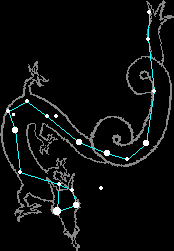
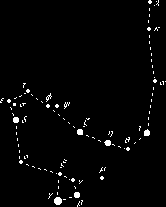
There are a number of myths behind the constellation Draco, due to its resemblance to a dragon, although alternative interpretations exist, such as the legend of the Mother Camels, the name given by ancient Arabic nomadic tribes to an asterism in the constellation of Draco. Instead of the head of a dragon, the asterism is interpreted as a ring of mother camels surrounding a baby camel (the faint star in the middle), with another mother camel running to join them. The camels were seen to be protecting the baby from a line of charging hyenas.
In the most famous of the myths, Draco represents Ladon, the hundred-eyed dragon that guarded the golden apples of the Hesperides.
The eleventh of The Twelve Labours of Heracles was to steal the golden apples. Heracles killed Ladon with a poisoned arrow, allowing him to freely take the golden apples. According to the legend, Hera later placed the dragon in the sky as the constellation Draco. Due to its position and nearby constellations in the zodiac sign of Libra (i.e. Ursa Major, Ursa Minor, and Bootes), the group of constellations can be seen to tell the tale of the eleventh labour.
In another legend, Draco represents the dragon killed by Cadmus before founding the city of Thebes, Greece. In a third legend, it represents the dragon that guarded the Golden Fleece and was killed by Jason. The fact that the stars of this circumpolar constellation never set plays an important part in its mythologies.
There are many myths behind Draco, due to its resemblence to a dragon. Dragon symbology represents human DNA.
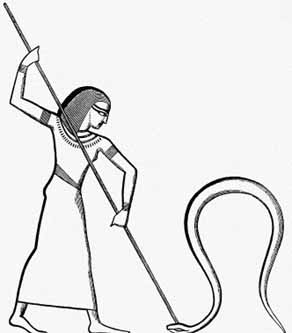
Slaying the Dragon Symbology - Omega, ending of human DNA - Leo - Lion
In the first legend, Draco represents the dragon killed by Cadmus before founding the city of Boeotia. In the second legend, it represents the dragon that guarded the Golden Fleece and was killed by Jason.
The Persians have regarded Draco as a man-eating serpent called 'Azhdeha'.
In early Hindu worship, Draco is given the form of an alligator known as 'Shi-shu-mara'.
The legend of Marduk is repeated in many cultures with similar tales of dragon slayers. Perseus, Hercules, Cadmus, Siegfried, Beowulf and St. George are all examples.
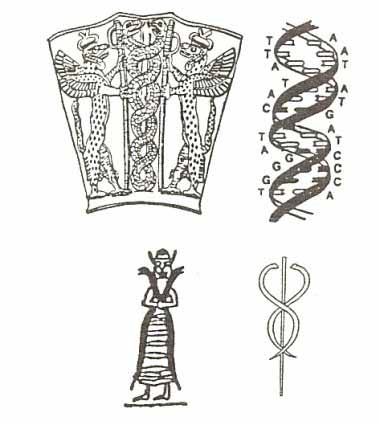
Anunnaki - Creational Gods - DNA
The origin of the constellation, Draco, and of most dragon lore as well, was probably the female Chaldean dragon Tiamat, the sea serpent who existed even before the sea and sky had been divided from each other, the dragon of chaos.
Tiamat was a monster of primeval darkness, just such a monster as exists in almost every mythology and must be overcome by the powers of sunlight before the creation of the world can take place.
The Sumerians and Babylonians those early inhabitants of the Tigris and Euphrates Valley from whom we have inherited so much of our mythology and astronomy alike, envisioned the beginnings of creation as a hazy state of chaos, a gloom that was nothing in itself and yet contained the potentialities of all things.
With the passing of time, the first gods arose from this primordial sea and come into conflict with the force that had given them birth, the deep, wild, creative but evil force of this ocean dragon Tiamat.
Tiamat gained possession of the Tablets of Fate, which were supposed to confer upon their owner the power to rule the universe, and gave them to her husband for safekeeping.
Then she challenged the authority of the newly risen gods and rose against them in rebellion, summoning forth out of the slimy depths all the most frightful creatures that her evil brain could conceive to help her in the struggle, monsters whose like has never been seen again: serpents whose fangs dripped poison, scorpion-men and fish-men and monster-dogs.
So horrible were these creations that even the gods took fright and hid themselves safely away in their airy heaven and no one of them would go down to meet Tiamat.
No one, that is, until at last Marduk of Babylon came forth from among them and offered to fight as their champion. He was equipped with special magic powers bestowed on him by each one of the other gods at a hurriedly summoned council of war and thus armed, he went down to face the sea serpent in battle.
Even Marduk trembled and almost lost heart at the sight of the dragon and her monster brood. But Marduk had both strength and cunning. He had on his side the winds of heaven and, summoning all their strength together, he sent these on before him and they blew straight into the jaws of the unsuspecting Tiamat.
They rushed through her open mouth in a surging current, with all the tearing force of those great hurricanes that sometimes sweep the sea, and blew so fiercely into the very bowels of her body that she was racked and split asunder; then Marduk finished off the helpless monster with a blow of his club.
The serpents and the dogs and the scorpion men were useless without the power of their evil genius, and presumably they slunk away and vanished into that yet untamed sea from which they had come. Some say that they are still to be seen in the darkness of heaven, where they have taken on the shape of the twelve signs of the Zodiac.
The north wind carried away the blood of Tiamat, and Marduk split her skull and tore her dragon skin into two pieces. With these he formed the heaven and earth, separating one from the other, and in the upper regions he set the homes of the gods, created the stars in the sky, and ordained the paths they should follow.
He outlined the constellations, placing them so that they should serve as signs to indicate the day, the years and the seasons to mankind. he fixed the dome of heaven in place with a great bolt, and set a watchman there to guard it. He surveyed the skies, and built the Zodiac. Then he rested from his labors, hailed by gods and men alike as the dragon slayer.
Early Greek myths tell of a great battle between the young gods and the older ones who had ruled for so very long. The new gods included Zeus and his brothers Poseidon and Hades. Known for its sharp vision and vigilance, Draco,
The Dragon was the traditional guardian of temples and treasures as well as the springs of life and immortality. Hera, Queen of the Gods, enlisted the assistance of Draco to serve as protector of the precious golden apples, which she had presented Zeus on the day of their wedding.
While performing this task, Draco was tragically slain by The Hero, Hercules, who stole away with the golden apples, which became a symbol of his immortality. Outraged by Hercules' daring accomplishment, Queen Hera rewarded Draco for his faithfulness by lifting him up into the sky to be remembered forever as a constellation and to be seen by all for eternity.
Athena was the Goddess of Arts, Crafts and War. There were also terrifying figures cast up out of the volcanic fires that belched out of the bowels of Earth. These monsters, who represented the universal forces of evil, were known as the Titans, or the Giants.
During the battle, which lasted for ten long years, one the Titans hurled a fierce dragon at Athena. So great was her strength and so effective her magic shield that Athena was not frightened. She caught the dragon and, with one mighty heave, swung him high into the heavens. Up he soared, twisting and coiling this way and that until his long body had become tied in knots.
He came to rest in the northern sky and became fixed to that region around which the northern stars circle. Today we see him forever asleep as the much-knotted, battered, and twisted Draco.
Articles in the News
Glow from first stars revealed in the Draco constellation BBC - November 3, 2005
Astronomers shed light on first stars to light Universe MSNBC - November 2, 2005
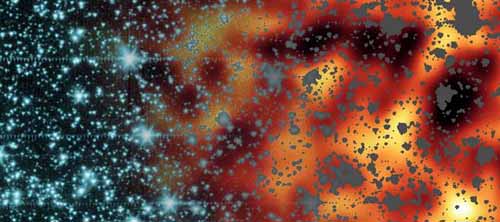
Astronomers say Draco's glow is the beginning of time Guardian - November 4, 2005
Astronomers have seen the beginning of time, using a space telescope that may have captured the primordial light from the first stars that formed after the Big Bang.
The latest images from Nasa's Spitzer telescope are thought to be the murky light given off by the first objects to form in the universe more than 13 billion years ago.An infrared camera on the Spitzer took pictures of the constellation Draco and scientists masked out all stars and galaxies to reveal the background glow from the first stars.
Researchers from Nasa's Goddard Space Flight Centre in Greenland, Maryland, compared the observations to the glow of city lights at night from an aircraft; the light is too feeble and too distant to resolve individual features.
"We think we are seeing the collective light from millions of the first objects to form in the universe," said Alexander Kashlinsky, the leader of the Nasa study in the journal Nature.
"The objects disappeared aeons ago, yet their light is still travelling across the universe."Cosmologists estimate that the Big Bang was 13.7 billion years ago. Some 200 million years passed after this act of creation before the first stars began to form from cosmic particles and dust.
Scientists believe these stars were likely to have been more than 100 times more massive than the Sun, and would have been hot, bright and relatively short-lived, each surviving a few million years compared to the billions of years of conventional stars.
Theorists predicted that the light from these primordial stars would be "stretched" by the expansion of the universe, so would exist not on the ultraviolet region of the spectrum but in the lower energies of the infrared region.
John Mather, a senior project scientist on the Spitzer telescope, said the aim was to capture all infrared light emanating from a region in the deep Draco constellation and process the data to remove light from more recent objects.
"We were left with a picture of part of the sky with no stars or galaxies, but it sill had this infrared glow with giant blobs that we think could be the glow from the very first stars," Dr Mather said.
The images could be the first pictures of so-called "population III" stars that were hypothesised as being formed soon after the Big Bang.
Population I and II stars are known to exist.In the early 1990s, another satellite, the Cosmic Background Explorer (Cobe), found all-pervasive microwave radiation in space thought to be the "echo" of the Big Bang.
Nasa said the latest findings from the Spitzer agree with the Cobe results, which had suggested that an infrared background would be found that could not be attributed to the known stars.
Related Files

The Garden of Eden
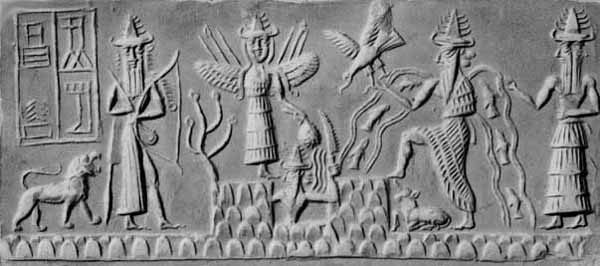
Sumerian Gods Allegedly Create a Biogenetic Experiment

Dilmun, Iraq
ShareThis
ASTRONOMY INDEX
ALPHABETICAL INDEX OF ALL FILES
CRYSTALINKS HOME PAGE
PSYCHIC READING WITH ELLIE
2012 THE ALCHEMY OF TIME

